There seems to be consistent questions, debate and studies done with respect to stretching. As the thought of more closely analyzing the quality of movement (FMS, Y-Balance testing, SFMA for example) moves to the forefront in the PT and fitness world, many search for the right mix of exercise to maximize mobility.
I count myself as a supporter and follower of the work of Gray Cook and Stuart McGill. While I may not agree 100% with all of their ideas, I generally consider them to be brilliant minds and ahead of the curve. I have been using the FMS in my practice for some time now and have also begun to incorporate Y-Balance testing as well (see pic below courtesy of the IJSPT)
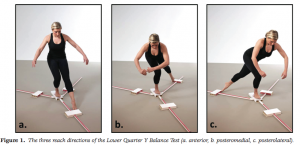
The Y-Balance test may not have significant relevance to hip mobility as much as it does limb symmetry, but I included it here to illustrate my point in observing kinetic chain movement to help determine where the weak link or faulty movement pattern may be. It gives us valuable information with respect to strength, balance and mobility.
With the revelation that FAI is more prevalent than we knew (click here for my post on FAI), I am always interested in hip mobility and how to increase movement in the hip joint. Limitations in hip mobility can spell serious trouble for the lumbosacral region as well as the knee.
I currently use foam rolling, manual techniques, dynamic warm-up maneuvers, bodyweight single leg and hip/core disassociation exercises and static stretching to increase hip mobility. However, I am often faced with the question of what works best? Is less more? How can I make the greatest change without adding extra work and unnecessary steps?
Well, Stuart McGill and Janice Moreside just published a study in the May 2012 Journal of Strength & Conditioning Research that sought to examine three different interventions and how they improve hip joint range of motion. Previous work has been focused on the hip joint alone, and they wanted to see how other interventions impacted the mobility of the hip. Click here for the abstract
In the study, they looked at the effect of core stabilization, motor training and myofascial stretching techniques on hip mobility in a selected asymptomatic group of healthy 24 young men with limited hip mobility (less than 50th percentile). The subjects were randomly assigned to one of four groups:
- Passive stretching only (traditional and myofascial) to improve hip rotation and extension
- Passive stretching as in #1 plus motor control exercises for the hip and trunk emphasizing hip and spine disassociation
- Motor control exercises and core endurance exercises (no stretching)
- Control group (no intervention at all)
As a renown back expert, McGill was looking to see how constraining torso movement may enable to the hips to take on more motion and have more available passive range of motion. This idea had been referenced in earlier work mentioned in the article. Perhaps, freeing up hip motion and improving core endurance and stability would reduce pain for those suffering low back pain? How important is passive stretching and including the myofascial component to address the adjacent structures?
Some key points in the study:
- All 4 groups attended the initial and final measurement sessions 6 weeks apart
- A home exercise program was individually tailored to each participant at the initial session based on group assignment, current hip flexibility, endurance (group 3) and movement patterns
- Participants were required to exercise no less than 4 days per week (given a logbook for tracking)
- Participants were asked not to change their normal workout routines
- Sample endurance and motor control exercises included: supine and prone hip rotation, Bird Dog, side bridges, unilateral carries, and supine single/double leg lowering
And now for the results……..
- Both stretching groups had significant improvements in hip ROM with mobility levels at or above the 75th percentile and average rotation improving between 29.7% and 56.6%, while extension increased 11.9 degrees on average
- Those in group 3 increased their ROM significantly in internal rotation and both total rotations averaging 18% and 10%
- As expected, the control group did not demonstrate any improvement
The key takeaways appear to be that including myofascial components to the stretch (selective arm and torso positioning) may be beneficial and considered in addition to (or perhaps in place of) selective hip stretching, and the fact that combining 6 weeks of core endurance hip/spine disassociation exercises with no stretching resulted in improved hip rotation. As such, rehab and fitness pros should strongly consider these types of exercises when addressing rotational deficits in clients with low back, hip and even knee pain/dysfunction.
I have been using some of McGill’s core exercises as well as my own with stability balls, planks and the BOSU to improve hip disassociation in my own clients. Here is an active mobility series I call hip “ins and outs” I use to enhance internal and external rotation in the standing position:
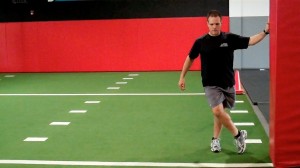
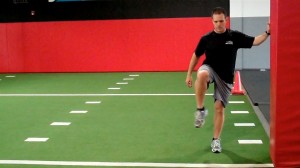
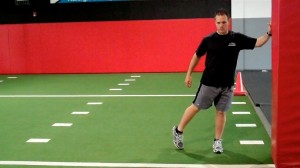
I utilize the following passive stretch to enhance internal rotation in supine but I encourage that it be done gently and with caution as it may create pain in those with active hip impingement or labral pathology.
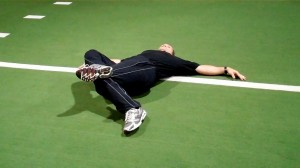
In addition to working on rotation, improving extension and activating the gluts/hamstrings is important while minimizing lumbar spine movement. Below is an example of such an exercise I like to progress to using a BOSU trainer (I begin in all fours on the floor):
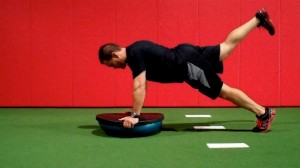
Clearly, limited IR and ER can be problematic in the closed chain for athletes. In particular, this study really yields great insight into training for golfers who often have asymmetrical rotation in their hips and demonstrate a higher risk for low back pain. With limited internal rotation during the back swing or follow-through the lumbar spine must increase its coil. The same could be said for other rotational sports as well.
We need more research looking at females, older adults and perhaps even sports specific populations moving forward. But for now, we have some new clues and tips for improving hip mobility with and without stretching.

